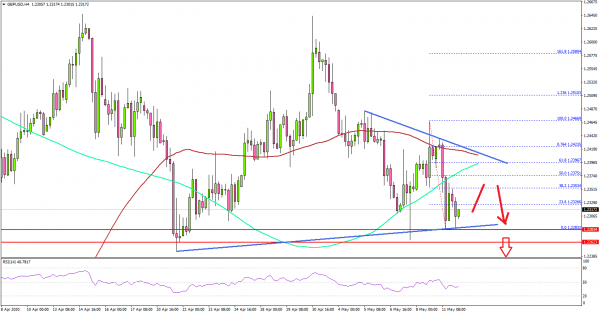Key Highlights
- GBP/USD failed to continue above 1.2450 and declined below 1.2350.
- A major resistance zone is forming near the 1.2400 level on the 4-hours chart.
- There is a risk of a larger decline if there is a break below the 1.2250 support zone.
- The US Consumer Price Index is likely to increase 0.8% in April 2020 (YoY).
GBP/USD Technical Analysis
This past week, the British Pound found support near the 1.2260 level and recovered against the US Dollar. However, GBP/USD failed to continue above 1.2450 and started a fresh decline.
Looking at the 4-hours chart, the pair traded as high as 1.2466 and declined below the 1.2400 support zone. Besides, there was a break below the 1.2350 support zone.
The pair tested the 1.2280 level and settled well below both the 100 simple moving average (red, 4-hours) and the 200 simple moving average (green, 4-hours).
On the downside, there are key supports near the 1.2260 and 1.2250 levels. If there is a downside break below the 1.2250 support zone, there is a risk of a larger decline towards the 1.2200 and 1.2150 levels.
Conversely, GBP/USD might attempt a fresh increase above 1.2350. However, there is a major resistance zone is forming near the 1.2400 level and a connecting bearish trend line on the same chart.
Therefore, a successful close above the 1.2400 resistance zone and the 100 simple moving average (red, 4-hours) is needed to start a convincing upward move in the coming sessions.
Looking at EUR/USD, the pair failed to clear the 1.0900 resistance and it is currently sliding towards the 1.0750 support zone.
Upcoming Economic Releases
- US Consumer Price Index April 2020 (MoM) – Forecast -0.7%, versus -0.4% previous.
- US Consumer Price Index April 2020 (YoY) – Forecast +0.8%, versus +1.5% previous.
- US Consumer Price Index Ex Food & Energy April 2020 (YoY) – Forecast +1.7%, versus +2.1% previous.














